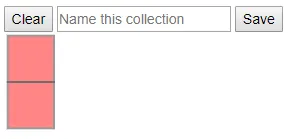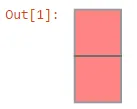使用纯JavaScript API 和
自定义 IPywidgets 系统 解决了这个问题。如果您复制并粘贴此代码,请注意单元格的顺序可能会显示不正确。
代码在此处可用。
用法
(第三个单元格)
import shapely.geometry as geo
some_nodes = [[0, 0], [0, 1], [0, 2], [1, 0], [1, 1], [1, 2]]
some_boxes = []
some_boxes.append([some_nodes[0], some_nodes[3], some_nodes[4], some_nodes[1]])
some_boxes.append([some_nodes[1], some_nodes[4], some_nodes[5], some_nodes[2]])
m_polygon = geo.MultiPolygon(geo.Polygon(box) for box in some_boxes)
poly_selector = PolygonSelector(m_polygon._repr_svg_())
poly_selector
工具长这个样子:

使用该工具后,您可以通过复制选择器工具实例的
groups_dict属性来获取当前选定的多边形索引,该属性是“实时”的。
(第4个单元格)
polygon_indexes = poly_selector.groups_dict.copy()
polygon_indexes
代码
工作仍在进行中,但下面是我最终做出的示例。这里也有一个链接到nbviewer上的笔记本(该工具在那里不可见)。
我把这个放在这里部分是为了自己的参考,但它也是其他人可以学习(和改进)的概念证明。有些东西不像我想要的那样工作——比如在选择对象时更改颜色。但主要功能,选择和保存点击的多边形,是有效的。
以下是代码单元格,按照我在上面链接版本中的方式逐个列出。
Python 代码
(单元格 #1)
import ipywidgets.widgets as widgets
from traitlets import Unicode, Dict, List
from random import randint
class PolygonSelector(widgets.DOMWidget):
_view_name = Unicode('PolygonSelectorView').tag(sync=True)
_view_module = Unicode('polygonselector').tag(sync=True)
groups_dict = Dict().tag(sync=True)
current_list = List().tag(sync=True)
content = Unicode().tag(sync=True)
html_template = '''
<style>
# polygonGeometry path{{
fill: 'pink';
}}
# polygonGeometry .selectedPolygon {{
fill: {fill_selected!r};
}}
# polygonGeometry path:hover {{
fill: {fill_hovered!r};
}}
{selection_styles}
</style>
<button id = "clearBtn"> Clear </button>
<input placeholder = "Name this collection" id = "name" />
<button id = "saveBtn"> Save </button>
<div id = "polygonGeometry">{svg}</div>
'''
fill_selected = "plum"
fill_hovered = "lavender"
group_colors = ["#{:06X}".format(randint(0,0xFFFFFF)) for _ in range(100)]
def __init__(self, svg):
super().__init__()
self.update_content(svg)
def update_content(self, svg):
self.content = self.html_template.format(
fill_selected = self.fill_selected,
fill_hovered = self.fill_hovered,
selection_styles = self.selection_styles,
svg = svg
)
@property
def selection_styles(self):
return "".join(f'''
# polygonGeometry .selection_{group_idx} {{
fill: {self.group_colors[group_idx]!r};
}}
''' for group_idx in range(len(self.groups_dict)))
JavaScript 代码
(单元格 #2)
%%javascript
require.undef('polygonselector');
define('polygonselector', ["@jupyter-widgets/base"], function(widgets) {
var PolygonSelectorView = widgets.DOMWidgetView.extend({
initialized: 0,
init_render: function(){
},
add: function(id) {
this.current_list.push(id);
console.log('pushed #', id);
},
remove: function(id) {
this.current_list = this.current_list.filter(function(_id) {
return _id !== id;
})
console.log('filtered #', id);
},
clear: function(thisView) {
return function() {
console.log('clear() clicked');
thisView.el.querySelector('#name').value = '';
thisView.current_list.length = 0;
Array.from(thisView.el.querySelectorAll('.selectedPolygon')).forEach(function(path) {
console.log("path classList is: ", path.classList)
path.classList.remove('selectedPolygon');
})
console.log('Data cleared');
console.log(thisView.current_list)
};
},
save: function(thisView) {
return function() {
console.log('save() clicked');
const newName = thisView.el.querySelector('#name').value;
console.log('Current name: ', newName)
if (!newName || thisView.current_list.length < 1) {
console.log("Can't save, newName: ", newName, " list length: ", thisView.current_list.length)
alert('A new selection must have a name and selected polygons');
}
else {
console.log('Attempting to save....')
thisView.groups_dict[newName] = thisView.current_list.slice(0)
console.log('You saved some data');
console.log("Selection Name: ", newName);
console.log(thisView.groups_dict[newName]);
thisView.model.trigger('change:groups_dict');
}
}
},
render: function() {
PolygonSelectorView.__super__.render.apply(this, arguments);
this.groups_dict = this.model.get('groups_dict')
this.current_list = this.model.get('current_list')
this.content_changed();
this.el.innerHTML = `${this.model.get('content')}`;
this.model.on('change:content', this.content_changed, this);
this.model.on('change:current_list', this.content_changed, this);
this.model.on('change:groups_dict', this.content_changed, this);
const polygons = this.el.querySelectorAll('#polygonGeometry path');
console.log('iterating through polygons');
var thisView = this
let arr = Array.from(polygons)
console.log('created array:', arr)
arr.forEach(function(path, i) {
console.log("Array item #", i)
path.addEventListener('click', function() {
console.log('path object clicked')
if (thisView.current_list.includes(i)) {
path.classList.remove('selectedPolygon')
thisView.remove(i);
console.log('path #', i, ' removed');
} else {
path.classList.add('selectedPolygon')
thisView.add(i);
console.log('path #', i, ' added');
}
thisView.content_changed();
});
console.log('path #', i, ' click set');
});
this.el.querySelector('#clearBtn').addEventListener('click', this.clear(this));
console.log('clearBtn action set to current view context');
this.el.querySelector('#saveBtn').addEventListener('click', this.save(this));
console.log('saveBtn action set to current view context');
console.log('render exit')
},
content_changed: function() {
console.log('content changed');
this.model.save();
console.log("Current list: ", this.current_list);
console.log("Groups dict: ", this.groups_dict);
},
});
return {
PolygonSelectorView : PolygonSelectorView
};
});

